Monocymbium ceresiiforme
Monocymbium ceresiiforme (Nees) Stapf
Family: Poaceae
Common names: boat grass, oat grass, wild oatgrass (Eng.); bootjiegras, hawergras, wildehawergras (Afr.); meseletso, mobeseletso (Sesotho); tshinwamulwadze (Tshivenda)
Introduction
Boat grass is an attractive, short, sometimes dense, tufted grass with a reddish tint. It is easily recognised by the single raceme with its fine, bent awn in a brightly coloured, boat-shaped spathe.
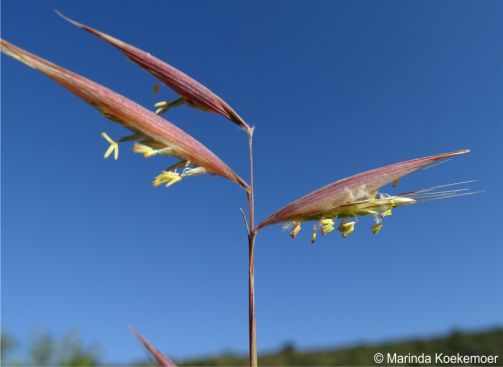
Description
Description
Monocymbium ceresiiforme is a loosely or densely tufted, graceful perennial 300–1 000 mm high; sometimes shortly rhizomatous; the plant turns reddish or purple-tinged when flowering. Leaf blade is 50–180 × 2–6 mm, dried leaves curled, like a cork-screw. Inflorescence of solitary racemes partly enclosed, in reddish-brown, boat-shaped spatheoles; spatheoles are 16–40 mm long. Sessile spikelet is 3–4 mm long; upper glume awn 3–6 mm long; upper lemma awn 6–15 mm long; anthers 1.5–2.0 mm long. Pedicelled spikelet is 4–5 mm long, anthers 1.5–2.5 mm long. Monocymbium ceresiiforme flowers from midsummer to winter (January to June).
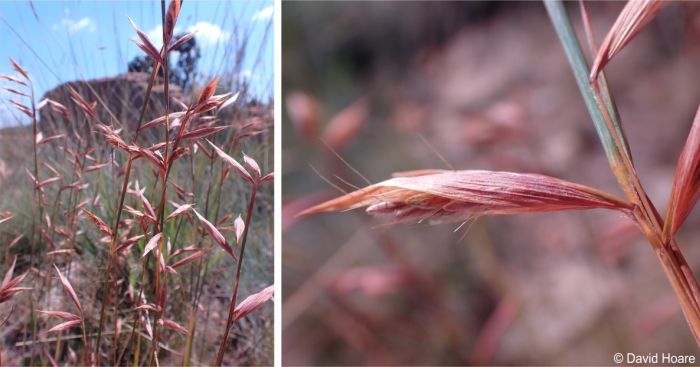
Conservation Status
Status
The current status of Monocymbium ceresiiforme, according to the SANBI Red List of South African plants, is assessed as Least Concern (LC). Boat grass is widespread in western and southern Africa and common throughout the higher altitudes of central Africa, southwards to the Eastern Cape.
Distribution and habitat
Distribution description
Monocymbium ceresiiforme is mainly found in southern Africa, Central Africa and West Africa. In South Africa, Monocymbium ceresiiforme occurs in Limpopo, North West, Gauteng, Mpumalanga, Free State, KwaZulu-Natal and the Eastern Cape Provinces. It is also found in Namibia, Botswana, Lesotho and Eswatini (formerly Swaziland). Boat grass grows on slopes in high altitude grassland with high rainfall. In areas with lower rainfall, boat grass is mostly found in sandy soil in places where water accumulates. In Central Africa it often forms a distinct zone around the edge of vleis at lower altitudes.
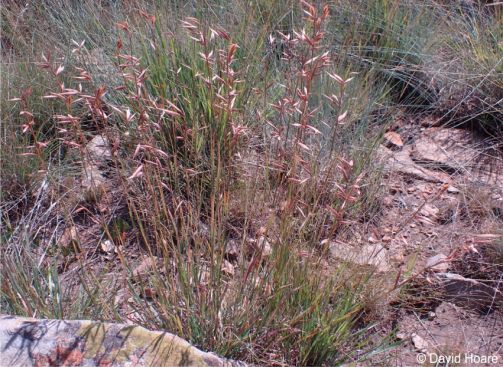
Derivation of name and historical aspects
History
The genus name Monocymbium is derived from the Greek words monos, meaning single and kumbe, meaning boat; each single raceme has a boat-shaped spathe. The species name ceresiiforme is possibly from the word Ceres, referring to the Roman goddess of agriculture, and forme refers to the shape, because of a superficial resemblance to oats.
The genus Monocymbium has ± 4 species, which are mainly found in tropical and southern Africa. There is just one species that occurs in southern Africa: Monocymbium ceresiiforme, which is widespread.
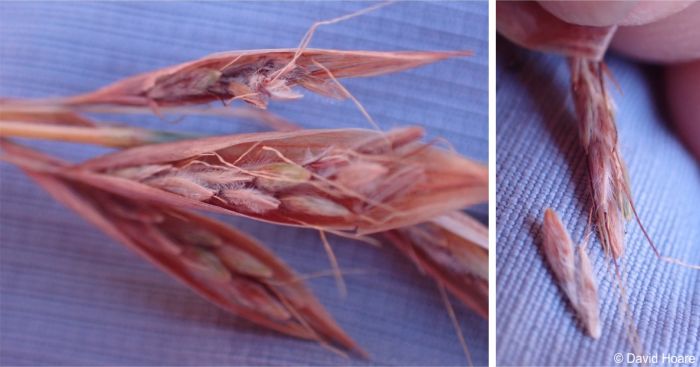
Ecology
Ecology
Boat grass is a good indicator of acid soils, open grassland and hillsides, often in wet places. It is also considered an indicator of a healthy veld. Its disappearance signifies poor veld management practices. It is well-suited to warm climates with grasslands and savannas. Monocymbium ceresiiforme is a water-wise and drought-tolerant grass. This grass is very hard and resilient. It is an attractive grass with a tufted, clump-forming growth habit.
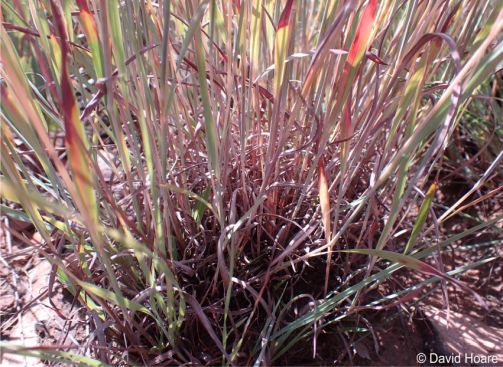
Uses
Use
Boat grass is an average grazing grass that becomes hard or less palatable as it matures. It is an indicator of sour highveld conditions and very often in Central Africa, especially in wet soil. Some people use boat grass to find or spot where there is acidic soil. It is apparently preferred by Oribi.
Growing Monocymbium ceresiiforme
Grow
Monocymbium ceresiiforme is easy to grow, planted in full sun and survives in a variety of soils, especially those found in grasslands, and shallow stony soils on hillsides. Boat grass grows fast and forms clumps. To propagate boat grass, dig up the clump and break the root ball into smaller sections, ensuring that each section has sufficient roots and foliage. Please cut some old leaves. Plant these individual sections in pots filled with fresh, well-drained potting soil, planting them deep enough so the soil comes up to about the level of your hand on the plant.Water thoroughly, ensuring the excess water drains from the pots. Keep them in a warm, bright location (full sun). This grass is water-wise, so provide moderate water when first establishing. Then, reduce watering as it grows.
References
- Chippindall, L.K.A. & Crook, A.O. 1976. Grasses of southern Africa. Collins, Harare.
- Fish, L., Mashau, A.C., Moeaha, M.J. & Nembudani, M.T. 2015. Identification guide to southern African grasses. Strelitzia 36: 271–276. South African National Biodiversity Institute, Pretoria.
- Hoare, D. 2022. Observation of Monocymbium ceresiiforme, City of Tshwane Metropolitan Municipality, Gauteng. iNaturalist. Online. https://www.inaturalist.org/observations/110579249.
- Koekemoer, M. 2024. Observation of Monocymbium ceresiiforme, Waterberg District Municipality, South Africa. iNaturalist. Online. https://www.inaturalist.org/observations/204893545.
- Leistner, O.A. (ed.). 2000. Seed plants of southern Africa: families and genera. Strelitzia 10. National Botanical Institute, Pretoria.
- Raimondo, D., Von Staden, L., Foden, W., Victor, J.E., Helme, N.A., Turner, R.C., Kamundi, D.A. & Manyama, P.A. (eds) 2009. Red list of South African plants. Strelitzia 25. South African National Biodiversity Institute, Pretoria.
- Van Oudtshoorn, F. 1999. Guide to the grasses of southern Africa. Briza Publications, Pretoria.
Credits
Dr. Aluoneswi Caroline Mashau
National Herbarium, Pretoria (PRE)
September 2025
Acknowledgements: images by David Hoare and Dr Marinda Koekemoer from their observations uploaded on iNaturalist.
Plant Attributes:
Plant Type: Grass
SA Distribution: Eastern Cape, Free State, Gauteng, KwaZulu-Natal, Limpopo, Mpumalanga, North West
Soil type: Sandy
Flowering season: Late Summer, Autumn, Winter
PH: Acid
Flower colour:
Aspect: Full Sun
Gardening skill: Easy
Special Features:
Horticultural zones
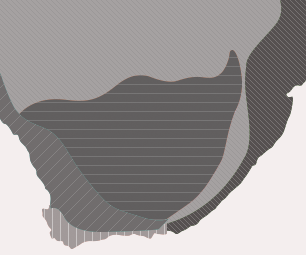








Rate this article
Article well written and informative
Rate this plant
Is this an interesting plant?
Login to add your Comment
Back to topNot registered yet? Click here to register.